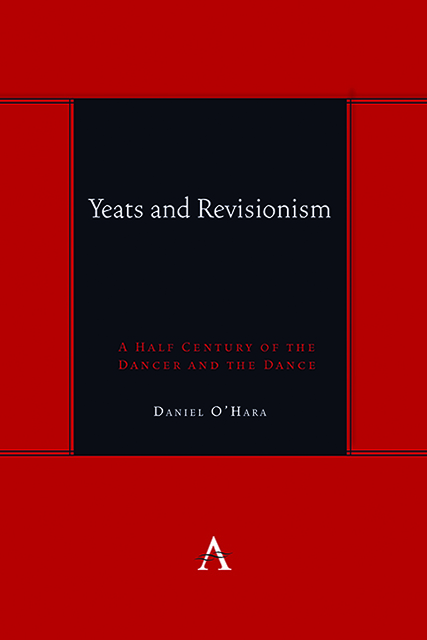Book contents
- Frontmatter
- Dedication
- Contents
- Acknowledgments
- Preface
- Introduction: Dancer and Dance: Yeats’s Romantic Modernism and Critical Revisionism
- Chapter 1 The Irony of Tradition in W.B. Yeats’s Autobiography: Dialectical Hermeneutics Beyond the New Criticism
- Chapter 2 The Specialty of Self-Victimization: On Antithetical Revisionism
- Chapter 3 Yeats in Theory: Blackmur, Bloom, De Man and Hartman
- Chapter 4 The Divisions of Yeats Studies Continued
- Chapter 5 Modernism’s Global Identity: on the Dogmatic Imagination in Yeats, Freud and Beyond
- Chapter 6 Yeats With Lacan: Toward the Real Modernism
- Chapter 7 The Spirit Medium: Yeats, Quantum Visions and Recent Lacanian Studies
- Chapter 8 And All the Ceremonies to Come: Of High Modernism, Visionary Violence and Post-Marxism
- Afterword: The Reader in Yeats
- Bibliography
- Index
Chapter 4 - The Divisions of Yeats Studies Continued
Published online by Cambridge University Press: 08 June 2023
- Frontmatter
- Dedication
- Contents
- Acknowledgments
- Preface
- Introduction: Dancer and Dance: Yeats’s Romantic Modernism and Critical Revisionism
- Chapter 1 The Irony of Tradition in W.B. Yeats’s Autobiography: Dialectical Hermeneutics Beyond the New Criticism
- Chapter 2 The Specialty of Self-Victimization: On Antithetical Revisionism
- Chapter 3 Yeats in Theory: Blackmur, Bloom, De Man and Hartman
- Chapter 4 The Divisions of Yeats Studies Continued
- Chapter 5 Modernism’s Global Identity: on the Dogmatic Imagination in Yeats, Freud and Beyond
- Chapter 6 Yeats With Lacan: Toward the Real Modernism
- Chapter 7 The Spirit Medium: Yeats, Quantum Visions and Recent Lacanian Studies
- Chapter 8 And All the Ceremonies to Come: Of High Modernism, Visionary Violence and Post-Marxism
- Afterword: The Reader in Yeats
- Bibliography
- Index
Summary
The Helm Information Critical Assessments of Writers in English, under the general editorship of Graham Clarke, is an invaluable aid to scholarship. For writers such as Henry James and George Eliot, the Brontë Sisters and D. H. Lawrence, this series generously makes available truly representative samples of contemporaneous reviews of writer's major works, as well as a wide range of general assessments and critical views up to the present moment. Today's scholars can discover in these finely edited, exquisitely handsome volumes, not only the histories of critical debates for their chosen writers, but they can also recognize the recurrent features of the writers’ oeuvres that have characteristically defined the object of study. I myself—selection entry number “305” in Volume 4—have found that what I think of as the divisions of Yeats studies have appeared and re-appeared insistently from the earliest reviews and commentaries right up to the latest studies. Such remarkable continuity makes one think that, despite their differences, all the generations of critics are addressing the same realities.
The primary division concerns the scholarly conflict about the state of the corpus. Next, there is the division in the field occasioned by the critical discussions about the status of Yeats’ occult system of belief. These divisions between matters of textual analysis (and construal) and critical judgments on the nature and value of Yeats’ religious worldview lead rather naturally to yet another divisive issue, the more speculative theoretical question of Yeats's identity—as a person, as a writer, and as a citizen influential in the formation of modern Ireland.
Yeats, as we know, was a constant reviser of his texts throughout his career. When he collected work in book form not only did he usually revise the individual texts therein many times over but also he would create ever-new arrangements for them that would vary from the first sometimes to all later editions. The first appearance of a poem, and the volume in which it was initially collected, would equally become material for subsequent acts of imaginative creation of increasingly powerful and also chronologically distorting symbolic and mythic patterns. For textual scholars and literary biographers or historians, the question of the “best” version of a poem or a volume is not necessarily answered by determining, when possible, Yeats’ so-called “final intention.” The question is, quite simply: “best” for what and whose purposes?
- Type
- Chapter
- Information
- Yeats and RevisionismA Half Century of the Dancer and the Dance, pp. 77 - 86Publisher: Anthem PressPrint publication year: 2022



